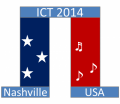Google Search
A2: Medium temperature materials
Thermoelectric power generation technology is hopefully expected to relax global energy problems by harvesting and converting waste heat into electricity. Thermoelectric oxides, composed of nontoxic, naturally abundant, light, and cheap elements, are expected to play a vital role in extensive applications for waste heat recovery in an air atmosphere. The thermoelectric conversion efficiency is decided by a “goodness factor” of ZT. We present a high ZT~1.4 in textured Bi0.875Ba0.125CuSeO prepared by a hot-forging process. After the hot-forging process, the carriers mobility along the direction perpendicular to the pressing direction was significantly increased, resulting in an increased electrical conductivity and a maximized power factor at 923K from 6.3 μWcm−1K−2 for the sample before hot-forging to 8.1μWcm−1K−2 after the hot-forging process. Although the corresponding total thermal conductivity was increased after hot-forging, this increment was more than compensated by the improved electrical conductivity. Therefore, the maximum ZT was significantly increased from 1.1 for Bi0.875Ba0.125CuSeO to 1.4 for the sample after three steps of hot-forging process, which is the highest ZT ever reported among oxygen containing materials.
